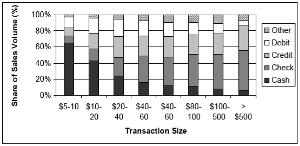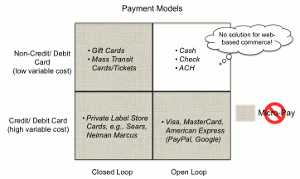
Forecasts for the magnitude of online micro-payments can whet the appetite of any profit-minded businessperson. However, cracking that code is more complicated than one thinks. There is little question as to whether sub-US$5 products can be sold in mass volume, but the lynchpin to opening the floodgates of micro-payments may very well be payment method.
Micro-payment business models work, and they work profitably. Some of the largest fortunes in America have been built on sales through micro-payments. Mars Corporation, Coca-Cola and Wrigley (I can glimpse the top of the Wrigley building if I lean “just so” out my office window) all made their fortunes selling goods at prices that can be labeled “micro.”
While vending and soda machines represent an automated micro-payment model, the question of whether micro-payments will work online is an altogether different one.
For one thing, online sales of physical items require shipping and handling that dwarfs the payment for the actual product and, consequently, limits micro-payments principally to the realm of digital content.
The iTunes Model
Apple, and specifically iTunes, is often held out as the archetype of a successful micro-payments business on the Web. It certainly is successful, but in order to reap the benefit of the micro-payment song purchase, customers likely have made a macro-payment to Apple for an iPod, iPod touch, iPhone — or, less often, Apple TV.
In other words, Apple is not a pure-play, micro-payment business model but it does demonstrate, with certainty, consumer demand for micro-purchases on the Web.
To get more insight into how a micro-payment business model might work on the Web, it is helpful to examine how the concept works in traditional brick-and-mortar commerce.
In brick-and-mortar stores, micro-payment businesses work well even when the costs of goods sold are high due to raw materials, manufacturing, distribution, inventory, wholesaling and retailing. Some even self-identify as micro-payment businesses, e.g., dollar stores.
Common characteristics of micro-payment retail sales:
- high volume
- consumer perishables (candy)
- included as an item of a larger total purchase (think grocery store)
- if part of a single purchase, low-cost and unmanned payment (think vending machine)
- often purchased with cash
It is interesting to examine the relationship between micro-payments and the fact that they are paid for with cash.
- All consumers, or almost all, prefer cash for some purchases that are often under $20 because cash is fast and convenient (Source: Visa U.S.A., 2005)
- For brick and mortar retailers, cash has a high fixed/low variable cost for processing. Until such time cash completely disappears, retailers will still require local bank accounts (and fees), balancing of cash drawers, trips for night deposits, etc. To put it another way, the cost of doing one more cash transaction per day is essentially zero, while the cost of doing one more card-based payment is just as high as the first, which also explains phenomena like minimums for card-based purchases.
We can safely conclude that consumers want and do make micro-purchases, online and offline, and that micro-payment business models are very sensitive to convenience and cost of processing. An exception to that rule exists for royalty-free digital content with zero variable costs, like virtual poker chips or digital sushi, for which the cost of payment is less critical.
Card-based solutions are neither convenient nor cost-effective for micro-purchases. PayPal or Google Checkout, by storing credit card information under email and password credentials, address the convenience of purchase, but both struggle on the cost side. PayPal is largely credit-card based, and Google Checkout is all card-based.
Efforts in the past to address the costs of card processing of micro-payments by aggregating transactions into a single batch have not been successful. Other efforts to jury-rig credit cards for micro-payments include forcing the customer to purchase “credits” in round increments like $20. Pre-selling credits creates a stored value and closed-loop payment system, akin to the gift cards sold at grocery line checkout or in mass transit ticketing, where the funds may be used only with a single merchant.
Closed-loop systems are annoying for the customer, requiring another username/password combination. Further, residual balances are scattered all over the place. On the merchant side, closed-loop systems create accounting, data security and potentially escheatment issues — i.e., unclaimed balances. Proprietary stored value systems are also expensive to maintain and operate, either eroding merchant margins or inhibiting consumer adoption due to fees passed on to them.
So, card-based solutions have not solved the problem — not due to a lack of effort, but rather because the economics are just not there. Closed-loop systems try to address the economics but create other problems, the most critical of which is customer hassle.
A Card Alternative
What is absent is a payment network that is easy, convenient and secure for consumers to use while also simple and cost-effective for merchants to accept.
Electronic checks, which settle using the Automated Clearing House (“ACH”), hold potential because ACH is a very low-cost settlement system. However, the problem with ACH is that it is just a settlement system, not a complete payment solution. It began in the early 1970s, batch processing payroll and installment loan payments. Unfortunately, little has changed since in terms of capability.
Electronic checks are hard for consumers to access without an intermediary, and there are fraud and other financial risks within the ACH system that make it difficult or inadequate for a merchant to accept as a form of payment.
Solution Framework
The diagram below frames payments systems along the key elements of cost and acceptance architecture. It makes clear the lack of options that are both open-loop and low-cost, and it explains the longstanding interest in and frustration with micropayments.
For all merchants — both online and brick-and-mortar — an electronic micro-payment solution must be based on the ACH system at its core, with as few intermediating layers as possible.
ACH alone, however, is inadequate. The solution will need to address the structural gaps in ACH around fraud and financial risk. The solution will need to seamlessly enable a wide array of payment types — including purchase, bill payments, recurring/subscription, international and person-to-person — without sacrificing security and ease-of-use for all parties in the transaction.
The payment solution will also provide a balanced set of consumer and merchant protections, effective reporting, prompt settlement and scalability. Further, the solution will need to be available across multiple channels — online, mobile, video game consoles, and any other emerging points of connectivity.
With just such a solution, digital content providers and other micro-payment merchants can go a long way toward capturing more revenue and value for their products and services.
Conrad Sheehan is the founder and CEO ofmPayy, a provider of online and mobile payment solutions for businesses and consumers.














































I would not bet on ACH as the infrastructure on which the solution for the micropayment industry will be built.
Alternative solutions, such as cellular, already solve part of the industry needs, yet the big breakthrough will take place once the credit card associations decide to make it happen.
Read the full article: http://www.creditcardprocessing-r-us.com/Credit_Card_Processing_Blog/2009/11/what-stops-the-online-micropayment-industry-from-breaking-through/
Gidi Argov, Founder and CEO
http://www.CreditCardProcessing-r-us.com